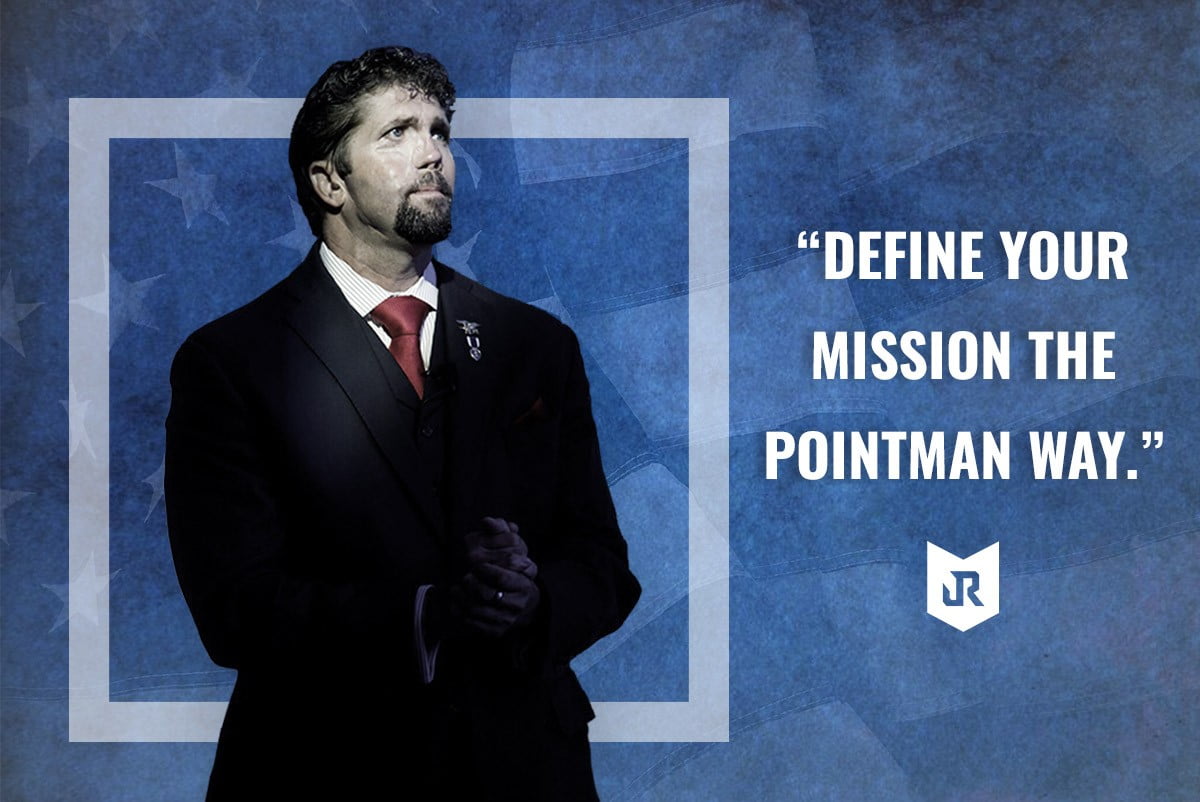Part I: Creating a Mission Statement the Pointman Way
Generally speaking I’m not one for allowing our emotions to drive decisions or relying on uninformed plans. Their random, influenced nature leaves too much to chance and too much potential for unnecessary vulnerability and ultimate defeat.
I’m all about research, situational awareness, strength and risk-mitigation balanced against cost-benefit sustainability and high morale along the short-term courses moving toward our long-term objectives.
But that wasn’t always my mindset. It took years, it took war, and it took wiser people than I to help forge, harden, break, repair, re-forge and redirect my pre-“Lead always and overcome all!” self. Building a high-quality, self-directed life required self leadership first and foremost; it took me becoming my own point man for my life.
What is a point man?
In military terms, a point man is the leader. The navigator. The danger seeker. The man or woman who possesses nerves of steel, an unworldly sixth sense and the proper training to detect dangerous ambushes lurking on the proverbial horizon.
At one point early in my Navy SEAL career, I was a point man. Later I relied on our point men to navigate our routes, identify the most efficient paths toward our objectives, and recognize and avoid potential ambushes and danger points along the way.
Since retiring, I’ve come to realize that life itself is no different. We all have missions and objectives in our personal and business lives, and any given path to attainment requires a clear course. It takes an understanding and avoidance of the dangers. It takes an uncanny awareness to detect and avoid obstacles, ambushes and any existing or potential threats to our progress. And most importantly it takes the conviction, experience and what I call the Overcome Mindset to stay the course toward achieving our objectives — even when things go wrong and we find ourselves, as we say in special operations, “on the X.”
In this four-part series I’ll share the four Pointman Principles outlined in my Pointman for Life program and its accompanying Pointman Planner (also available stand-alone), all extensions of the relative concepts in my best-selling book “Overcome: Crush Adversity with the Leadership Techniques of America’s Toughest Warriors.” I first developed and applied these principles for years in my own life before further streamlining and shaping the model to be applied to anyone’s. They’re the framework to embrace as a solid foundation for everything you’re serious about building in your personal and professional life (and this article will expand on #1):
- Relentless belief in a clearly defined Mission.
- Specific Destination and set Course.
- Situational Awareness and Risk Assessment.
- Overcome Mindset to R.E.A.C.T. and rapidly “Get off the X.”
What is a personal or employee mission?
A personal mission pertains to the long-range intentions and steadfast big-picture vision for the life and legacy of an individual and the execution of objectives in support of it. In business, this can extend to his or her work ethic and/or company leadership. It is values-based and should be considered the baseline for everything moving forward and everything and everyone drawn into it along the way.
What is a mission statement?
A mission statement is a definitive, clarifying summary inclusive and reflective of the mission-related intentions, values and end-game objectives. Whether it’s displayed publicly, as in to the marketplace in business, or kept internally within the confines of a small team, a home or one’s own mind and heart, when written and often reviewed it is an excellent tool for quick-reference and navigational reinforcement.
In the SEAL teams, our mission statements were critical. They guided us when things went right. And they kept us focused, resilient, decisive and on course when things were (quite literally) blowing up all around us.
The most successful people I know have a professional or personal mission statement. It defines them. It’s their compass in on their journey and their rock in the midst of storms. It guides their decision making as they navigate life and business, and it keeps them grounded and focused on what is most important. And when things get most difficult, and they are overwhelmed by the chaos and carnage of what I call a life ambush, their mission statement is a beacon, a light in the darkness, that guides them off the X and back on course.
How to create a personal mission statement
Define your mission
Proper execution of one’s mission requires the clear definition of and unwavering belief in it. The process for defining it isn’t typically quick and easy, but it is rather simple, and the results are worth the effort. How to:
- Ponder and list 10 to 15 personal values that most resonate with you. Then narrow them down to five that most define you.
- Let your values shape and integrate with your creation of a who, what, when and where statement, as in: Who are we? What are we here to do? When? Where? (I’ll cover the how in article #2 of this series, setting Destination and Course.)
- Use your defined values and your who, what, when and where statement to further flesh out a clear and succinct paragraph or two that represent and support your big-picture vision.
My own Jason Redman Mission Statement reads as follows:
I want to motivate and inspire others to lead themselves and achieve greatness. I want to be regarded as a Pointman for my own life and for others. I want to be a positive role model and mentor of leadership, the Overcome Mindset, health, compassion, and communication always. I want to be regarded as someone who holds himself and others accountable. I want to be a good father, son, husband and friend.
Defend your mission
Now put your new mission statement to the test with three questions regarding your relentless belief in and commitment to the integrity of it:
Do you believe in it?
Are you believable? Are your actions and values in practice actually in alignment with your mission statement? Or is your statement nothing more substantial than ink on paper or words on a wall in your office?
Can you live it? Do you, or will you, execute on your mission at all times? If you can lead yourself and others always in alignment with your mission statement, you will be living your mission. And people will take note, and they will want to join your team.
Your mission statement doesn’t need to be perfect, and it may change over time. Strive now for clarity and direction, not exactness. If it incorporates the elements and passes muster, you’re good to proceed.
Review it quarterly. As a self aware leader, ask yourself if it will take you where you want to go in life or business and if it remains in alignment with the goals, values and people you hold dearest. Update it as necessary; it can only improve.
Article #2 will move you through Principle Two, establishing Destination and Course.
I’ll meet you there. Until then know that, Pointman to Pointman, I support your worthy mission to lead yourself, lead others and lead always in pursuit of life’s greatest virtues.
Jay



